
The domino effect of overpronation in the right foot.
As the arch is dropping down 1 to 2 cm, the collapsing foot will throw your overall skeletal system out of alignment. How? By:
- pulling your right knee downwards & inwards;
- tilting down your right hip bone;
- twisting your spine all the way up to the neck;
- shifting your right shoulder up!
Custom-made orthotics support feet up to the spine!
As your right arch is kept up into good position, your right foot will support your whole body into good alignment. How? By:
- keeping your right knee up & straight;
- leveling up your right hip bone;
- aligning your spine all the way up to the neck;
- lining up your shoulders with the ground!
1. Feet are our foundation. But overpronation throws our body out of alignment!
Notice the domino effect a collapsing overpronated right foot will impose onto the overhanging skeletal system.
Let’s say your right foot is overpronating so your arch height drops down 1 to 2 cm each time you stand or walk around.
Your collapsing foot will pull your right ankle, knee and hip downwards. It will also twist-in your right leg and your spine all the way up to the neck.
Note that your right shoulder level must go up to compensate for the lower limb collapse.
2. Why should I wear custom-made orthotic medical devices?
As the arch of the unsupported and overpronating right foot is dropping down, the back of the heel bone is forced to twist inwards, 15 degrees off from the vertical. Then the forefoot and lesser toes must shift on the outside. The uncorrected right heel and leg are out of alignment!
Compare with the normal straight alignment obtained for this left foot, ankle and lower leg, once the bottom of the left foot and its arch are supported with a custom-made personalized fit orthotic medical device. Here, the back of the heel bone has been precisely repositioned in straight line with the lower leg. Both corrected left heel and leg are exactly perpendicular to the ground!
Feet are the foundation of our whole body. Supporting fallen arches or correcting misaligned, overpronated, collapsed or flat feet with precisely fit custom-made orthotic medical devices most often lead to many benefits all the way up to the ankles, lower legs, knees, thighs, hips, back, shoulders and neck.
Only a few weeks after they were fit with their new orthotics, most patients report that their limiting foot pain is a thing of the past and they are back to their preferred physical activities. And many of them will spontaneously share with us that the on and off to nagging pain they have had for ever in their lower legs, knees, thighs hips or lower back is gone! They just can’t believe it!
If you have pain in your feet and at some area in your lower limbs or back, most likely your feet are in desperate need for the type of support necessary to keep them pain-free. You already know this one. But remember. Only pain-free feet are stable and strong enough to keep your overall musculoskeletal system in optimal alignment, performance and comfort. Why? Feet are the foundation of the body.
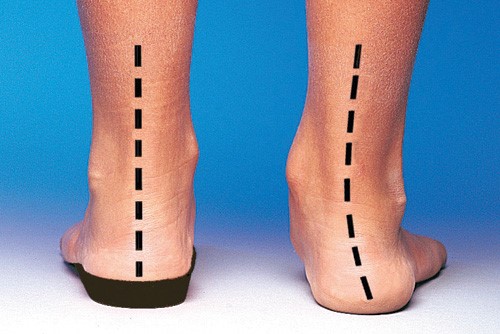
3. Why having your custom-made and personalized-fit orthotic medical devices dispensed at Ottawa Foot Clinic?
Simply because your orthotic medical devices dispensed at Ottawa Foot Clinic will be especially designed to help you enjoy more out of each day and to:
- Support your feet and whole body up to the spine;
- Alleviate to eliminate most of your arthromusculoskeletal foot, ankle, leg, knee, hip and back pain;
- Put you back into your game or back into your preferred physical activities;
- Compensate foot and body musculoskeletal dysfunction, misalignment and deformity;
- Helping you get less fatigue and more energy both at work and at home.
4. Know what are the most popular custom-made orthotic designs dispensed at Ottawa Foot Clinic?
- ¾ Orthotics minimally covers the bottom of your feet. It provides all the support any mild to moderate overpronator will need to restore optimal feet and body alignment and load distribution. ¾ orthoses only extend from the bottom back of the heel down to 5 mm short of the toe joints. They may be dispensed on shell or cushioned with a top cover material.
- Sulcus Orthotics have the supportive polymeric shell topped with a cover material extended to the ball of the foot and tapered down under the toe crease so you won’t feel the end. This sulcus-length device provides cushioning while preserving toe space in thigh and shallow dress shoes.
- Full-length orthotic designs provide maximum stability and cushioning. These may be ideal for you. Especially if the ailing balls of your feet need some offloading in your casual shoes and working boots. Especially if you are affected with age-related fat pad atrophy and migration so you end up walking directly on your ailing heel bones and toe joints.
5. Our Adult ¾ Orthotics – Classic Designs for Classic Dress Shoes
Our ¾ dress shoe adult orthotics combine discretion, comfort, foot support and skeletal alignment correction thanks to its ultra-thin 2 mm polymer shell that fits and feels like a second skin. The skin color shell is highly polished with a brilliant odor-free shine that may last maintenance-free for over a decade! Precise extensions of the outer shell contours into the arch and toward the forefoot will share body load evenly down to the 5 metatarsal bones, ball of your foot and toe joints.
We prescribe 3 types of shell outline under the heel:
- Full heel coverage and contact for maximum rearfoot stability and control;
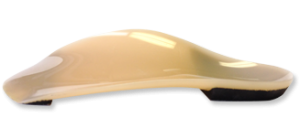
- A round opening of 15 mm in diameter (the size of loonie) to prevent your heel from lifting out of your dress loafer shoes;
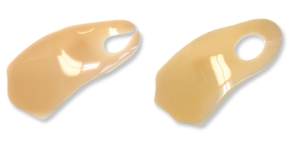
- A U-shaped opening to increase the flexibility of the device and lower its corrective power in cases where osteoarthritic degenerative changes detected on x-ray views would limit the amount of foot control you are able to tolerate.
We offer a huge variety of top cover materials
Performance is based on comfort, cushioning, grip, stability and perspiration control.
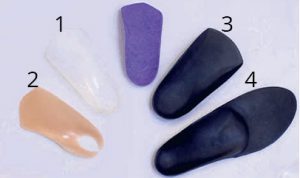
1 – Translucent shell ¾ orthotic
2 – Skin-colored shell ¾ orthotic
3 – Shell ¾ orthotics cushioned with a top cover materiel
4 – Full-length orthotic design = more stability and cushioning. Meant to replace the unsupportive removable insoles into casual, sport and work shoes and boots.
Our Full-length Orthotics – To Fit Running & Casual Shoes to Working Boots
Pure shell orthotic 3/4 designs, ¾ orthotics cushioned with a top cover material will provide you with the foot alignment and support you need while fitting quite well into tight dress shoes. ¾ Shell or top covered orthotics are just easier and faster to flip from nice dress shoes to elegant dress boots.
Full-length orthotic designs provide more stability and cushioning. These may be ideal for you. Especially if the ailing balls of your feet need some offloading in your casual shoes and working boots. Especially if you are affected with age-related fat pad atrophy and migration so you end walking directly on your ailing heel bones and toe joints.
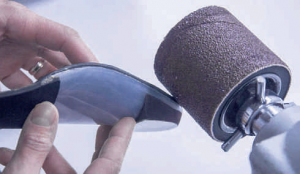
All our orthotics are prescribed according to your particular foot conditions. And to address your specific foot ailments. They are precisely in-office contoured so they will nicely sit down in your shoes. Your medical orthotic devices are custom-made here in the Ottawa Valley. We make sure they fit the bottom of your feet just like gloves. We make sure they support your whole body in its most favorable alignment.
6. Our Pediatric Orthotics – Especially Designed and so Beautifully Decorated!

This very unique pediatric orthotic design is comprised with some colorful ‘’butterflies” flying inside the body of the shell. We observe a better Children’s compliance when they are invited to select the decorative shell pattern that matches their liking.
In no time, children say good-bye to nagging growing pains and to abnormal in-toe gait conditions.
This shell orthotic design ensures optimal child’s compliance, pediatric foot support and gait control. A powerful but gentle growing orthotic guidance for your children’ legs, knees, hips and back will take place over the next 12 to 18 months. Abnormal in-toe gait due to excessive internal leg rotation will be addressed with a special shell extension that will progressively derotate the twisted-in growing leg. Kids and teens are having much thicker natural fat pads under their feet than adults do. Hence, no need to add cushioning material on top of the polymer shell. Water-resistant and very versatile, they can be easily flipped from any shoes to any boots. And be worn in dressier school or party shoes.
Let your child select the most compelling look to trigger full compliance!
Available in fun designs, our pediatric foot orthoses come with a polymer shell that is sufficiently flexible and thin to provide room for the foot to grow, but also sturdy enough to support fallen arches and to correct an abnormal child’s posture and gait pattern. Our pediatric orthoses permanently correct gait disorders. They simply can’t be worn out -except chewed up by overenthusiastic dog’s teeth! And they are super resistant to impact. They protect the plantar surface for activities that are extremely demanding on the feet.


Let your children grow their overall skeletal system the most favorable way
By promoting the realignment of the feet and overhanging skeletal system up to the neck, the pediatric orthosis directly addresses problems most likely to worsen and be detrimental to a child’s development and sports ‘performance. Various biomechanical corrective postings will support most advantageous growth of their developing bones and joints. From feet up to the spine! By paying special attention to the age and growth curve of the child, we can extend the orthosis a little longer to prolong its useful life.
Our philosophy is to think outside the box and exceed our customers’ expectations, providing exceptional orthoses that are tailored to the needs of everyone. For children under the age of 13 whose growth is more rapid, Ottawa Foot Clinic offers a free 18-month replacement policy following the purchase of a Pediatric foot orthosis when you buy the extended warranty.
7 . How can I detect if my child is pronating too much?
A reasonable amount of cholesterol is good for our body! So is pronation. A normal range of motion with in the foot and ankle joints – pronation – is necessary for the foot and ankle to adapt to uneven ground levels and to absorb part of the impact to protect the whole skeleton up to the spine! But excess pronation is bad! It will impose weight bearing body joints to function out of alignment for decades. And premature wear and tear on articular facets, ligaments and disks whenever present in knee, hip and spine joints. This may lead to premature osteoarthritis, knee or hip replacement and lower back surgery! All of this can be avoided to your child if early detection and correction are achieved. Here are things to look at.
The left foot of this 7-year-old boy is showing signs of overpronation on this posterior view:
- Three lesser toes are shifted to the lateral side of his foot as the big toe is hidden by his rolled-in ankle;
- The back of the left heel, rearfoot and ankle are slanted inwards;
- The inner malleolus of the left ankle is sticking out excessively toward the right one;
- The vertical height between the tip of the medial malleolus and the ground is reduced by 1 cm;
- The profile of the lateral aspect of the Achilles tendon of this left foot and ankle is deeply curved inwards.
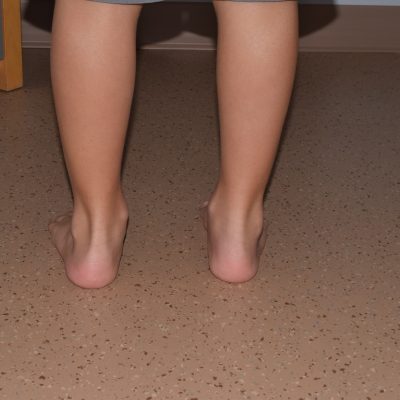
The right foot is showing signs of a desirable straight alignment for optimal support of the overall skeleton:
- Only ½ of the big toe and ½ of the pinky toe are showing up on each side of his right foot and ankle;
- The back of the heel, rearfoot and ankle are quite perpendicular to the ground;
- The inner malleolus of the right ankle shows a much straighter profile than the left one;
- The level of the tip of the medial malleolus of the right ankle is higher up than the left one by one centimeter.
- The profile of the lateral aspect of the Achilles tendon of this right foot and ankle is much straighter and normal.
This side view of this walking child shows how flat the arch of the left foot is. The summit of the arch has collapsed down to 5 mm from the ground level.
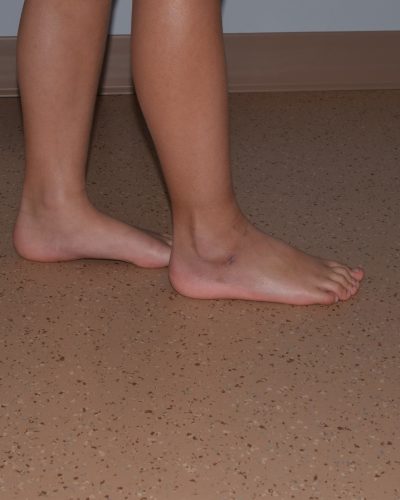
This side view now shows the normal arch profile of the right foot. The top of the arch is close to 15 mm from the ground level.

8. Foot Support Provided by Custom-made Orthotics dispensed at Ottawa Foot Clinic.
When you are sitting feet off the ground, your unloaded foot profile will show your normal arch height.

Here a custom-made medical orthotic device is fit under the left unloaded foot.
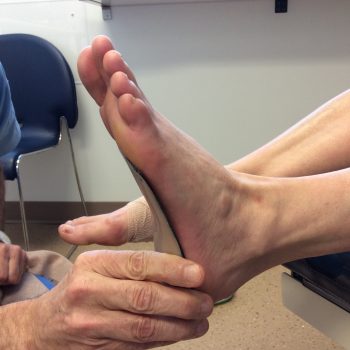
The orthotic will be gently secure under the unloaded left foot using a cohesive flexible bandage.
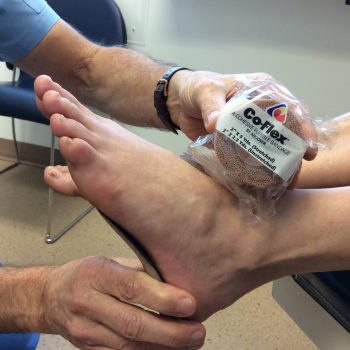
The front part of the orthotic is now secure to the foot.
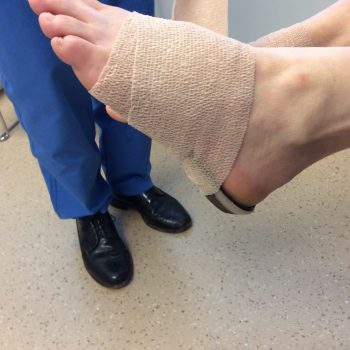
Now the patient is standing and loading his feet with her full body weight.
Notice the normal arch profile of the right foot. Appreciate the straight alignment of the left foot, ankle and lower leg. The result you see here are provided by the sole support of custom-made orthotic devices secured into place by elastic skin-tone bandages. Imagine the added support you will get whenever you’ll be wearing your orthoses in conjunction with supportive shoes.

